Chapter: Microprocessor and Microcontroller
8051 interrupts
Interrupts
8051
provides 5 vectored interrupts. They are

are
external interrupts whereas Timer and Serial port interrupts are generated
internally. The external interrupts could be negative edge triggered or low
level triggered. All these interrupt, when activated, set the corresponding
interrupt flags. Except for serial interrupt, the interrupt flags are cleared
when the processor branches to the Interrupt Service Routine (ISR). The external
interrupt flags are cleared on branching to Interrupt Service Routine (ISR),
provided the interrupt is negative edge triggered. For low level triggered
external interrupt as well as for serial interrupt, the corresponding flags
have to be cleared by software by the programmer.
The
schematic representation of the interrupts is as follows -
Interrupt

Each of
these interrupts can be individually enabled or disabled by 'setting' or
'clearing' the corresponding bit in the IE (Interrupt Enable Register) SFR. IE
contains a global enable bit EA which enables/disables all interrupts at once.
Interrupt Enable register (IE): Address:
A8H
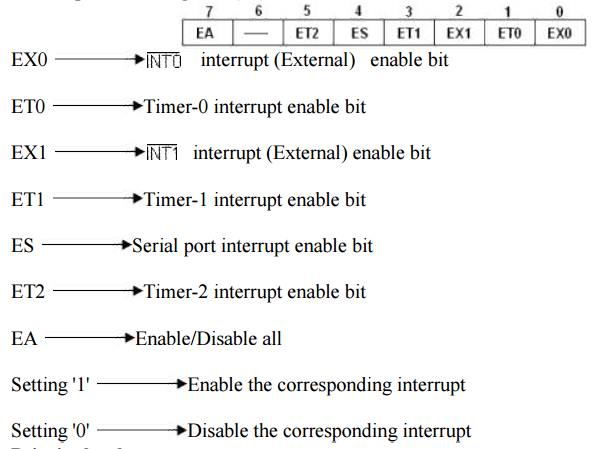
Priority level structure:
Each
interrupt source can be programmed to have one of the two priority levels by
setting (high priority) or clearing (low priority) a bit in the IP (Interrupt
Priority) Register . A low priority interrupt can itself be interrupted by a
high priority interrupt, but not by another low priority interrupt. If two
interrupts of different priority levels are received simultaneously, the
request of higher priority level is served. If the requests of the same
priority level are received simultaneously, an internal polling sequence
determines which request is to be serviced. Thus, within each priority level,
there is a second priority level determined by the polling sequence, as
follows.
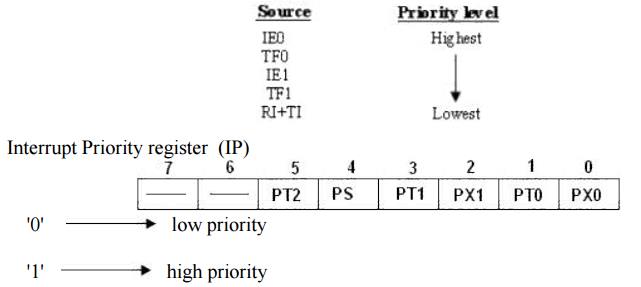
Interrupt handling:
The
interrupt flags are sampled at P2 of S5 of every instruction cycle (Note that
every instruction cycle has six states each consisting of P1 and P2 pulses).
The samples are polled during the next machine cycle (or instruction cycle). If
one of the flags was set at S5P2 of the preceding instruction cycle, the
polling detects it and the interrupt process generates a long call (LCALL) to
the appropriate vector location of the interrupt. The LCALL is generated
provided this hardware generated LCALL is not blocked by any one of the
following conditions.
1. An
interrupt of equal or higher priority level is already in progress.
2. The
current polling cycle is not the final cycle in the execution of the
instruction in progress.
3. The
instruction in progress is RETI or any write to IE or IP registers.
When an
interrupt comes and the program is directed to the interrupt vector address,
the Program Counter (PC) value of the interrupted program is stored (pushed) on
the stack. The required Interrupt Service Routine (ISR) is executed. At the end
of the ISR, the instruction RETI returns the value of the PC from the stack and
the originally interrupted program is resumed.
Reset is a non-maskable interrupt. A
reset is accomplished by holding the RST pin high for at least two machine cycles. On resetting the program starts from
0000H and some flags are modified as follows –
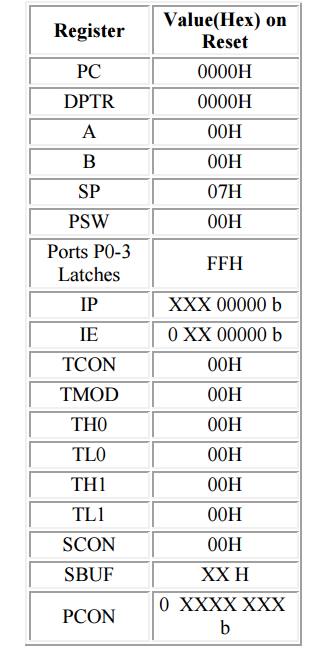
The
schematic diagram of the detection and processing of interrupts is given as
follows.
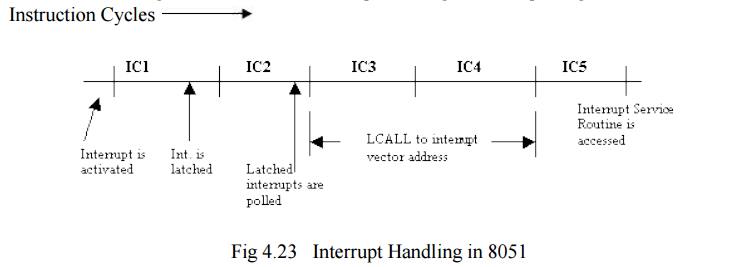
It should
be noted that the interrupt which is blocked due to the three conditions
mentioned before is not remembered unless the flag that generated interrupt is
not still active when the above blocking conditions are removed, i.e. ,every
polling cycle is new.
Jump and Call Instructions
There are
3 types of jump instructions. They are:-
1. Relative
Jump
2. Short
Absolute Jump
3. Long
Absolute Jump
Relative Jump
Jump that
replaces the PC (program counter) content with a new address that is greater
than (the address following the jump instruction by 127 or less) or less than
(the address following the jump by 128 or less) is called a relative jump.
Schematically, the relative jump can be shown as follows: -
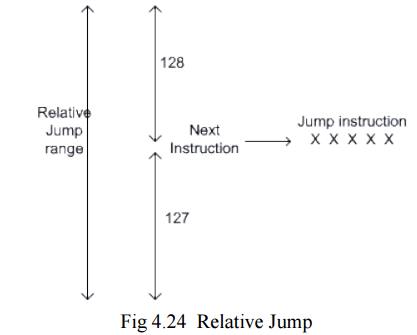
The
advantages of the relative jump are as follows:-
Only 1
byte of jump address needs to be specified in the 2's complement form, ie. For
jumping ahead, the range is 0 to 127 and for jumping back, the range is –
1 to
-128.
2. Specifying
only one byte reduces the size of the instruction and speeds up program
execution.
3. The
program with relative jumps can be relocated without reassembling to generate
absolute jump addresses.
Disadvantages
of the absolute jump: -
1. Short
jump range (-128 to 127 from the instruction following the jump instruction)
Instructions
that use Relative Jump
SJMP
<relative address>
(The
remaining relative jumps are conditional jumps)
JC
<relative address> JNC <relative address> JB bit, <relative
address> JNB bit, <relative address> JBC bit, <relative address>
CJNE
<destination byte>, <source byte>, <relative address> DJNZ
<byte>, <relative address>
JZ
<relative address> JNZ <relative address>
Short Absolute Jump
In this
case only 11bits of the absolute jump address are needed. The absolute jump
address is calculated in the following manner.
In 8051,
64 kbyte of program memory space is divided into 32 pages of 2 kbyte each. The
hexadecimal addresses of the pages are given as follows:-
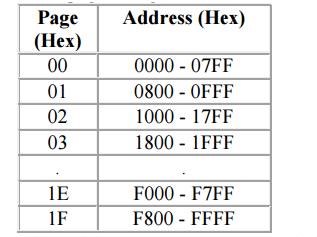
It can be
seen that the upper 5bits of the program counter(PC) hold the page number and
the lower 11bits of the PC hold the address within that page. Thus, an absolute
address is formed by taking page numbers of the instruction (from the program
counter) following the jump and attaching the specified 11bits to it to form
the 16-bit address.
Advantage:
The instruction length becomes 2 bytes.
However,
difficulty is encountered when the next instruction following the jump
instruction begins from a fresh page (at X000H or at X800H). This does not give
any
problem
for the forward jump, but results in an error for the backward jump. In such a
case the assembler prompts the user to relocate the program suitably.
Example
of short absolute jump: - ACALL <address 11>
AJMP <address 11>
Long Absolute Jump/Call
Applications
that need to access the entire program memory from 0000H to FFFFH use long
absolute jump. Since the absolute address has to be specified in the op-code,
the instruction length is 3 bytes (except for JMP @ A+DPTR). This jump is not
re-locatable.
Example:
-
LCALL
<address 16>
LJMP <address 16>
JMP
@A+DPTR
Related Topics